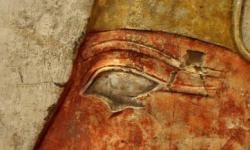The ancient Egyptians fascinate us. Our modern culture devotes museums, books and movies to the study and celebration of Egyptian society and traditions. From King Tut mania to Elizabeth Taylor's Cleopatra, we're obsessed. This is likely because they left behind so many well-preserved artifacts and we have so much to sift through and admire.
One facet of the ancient Egyptian culture we find particularly interesting is their use of makeup. Even for the afterlife, the Egyptians found cosmetics important. It's not uncommon for archaeologists to find small clay pots of makeup in even the most humble tombs. Yes, beauty was important to the Egyptians, but makeup served another purpose. Some of their beautification rituals also helped protect them from the elements -- repelling insects or warding off the sun's burning rays. Many times, the application of makeup also served as a ritual to honor their gods or goddesses.
Advertisement
So what sort of makeup and beauty items did our ancient Egyptian friends favor? How do our cosmetics today compare? Keep reading to find out.
